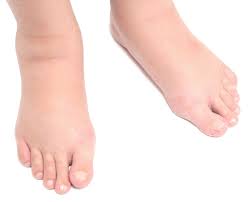
Swelling of the feet and ankles appears frequently after spending several hours standing or sitting, the soft tissues becoming painful or tender.
This is a very common problem, and in general it’s not a major cause for concern; peripheral edema, as the symptom is scientifically referred to, consists of the accumulation of fluid in the lower body, as a result of impaired blood or lymph circulation, sedentariness or simply gravity. The manifestation occurs more frequently in the elderly but is also present in young adults, and pregnant women are very likely to struggle with feet and ankle swelling for weeks or months of their pregnancy.
If the accumulation of fluid and the discomfort are the only symptoms you’re experiencing, it’s probably not a more serious underlying health problem, but if the swelling occurs regularly and is accompanied by shortness of breath, fatigue, feelings of faintness, concentration problems and confusion, dizziness or pain and tightness in the chest area, it may be triggered by a severe health problem, so you should see your doctor right away.
The soft tissues swell when fluid builds up inside the body, due to the reduced blood flow and the inefficient drainage of lymph. Gravity increases the pressure and amount of blood in the vessels of the lower body, so this is why you’re more likely to experience swollen legs instead of hands. If you wear tight clothes and shoes that don’t allow the blood to travel freely through the vessels, then the probability to end your day with painful and swollen feet increases.
Usually lying down and resting your legs for a couple of minutes or hours reduces the swelling and discomfort, but if it doesn’t and the symptom persists, it may be the sign of a serious underlying issue. Given below are 6 potential causes of limb swelling that can be more or less threatening.
One is considered obese if their BMI (body mass index) exceeds 30, but even people who are not obese yet carry a lot of extra weight on their bodies are prone to feet and ankle swelling and increased fluid retention. The extra pressure caused by the excess pounds impairs the flow of lymph through the tiny vessels in the limbs, and favors fluid buildup.
Sprained ankles are one of the most common causes of fluid buildup in the legs. This condition can occur as a result of strenuous exercise, stretching, or a misstep, and affects the ligaments and joints that connect the ankle bones. Strains, which affect the muscles and tendons and can be caused by the same factors, can also favor the accumulation of fluid in the limbs, leading to pain, swelling, and a limited range of motion.
When the lymph nodes or vessels get damaged, the fluid builds up in the tissues and swelling occurs. The symptom is called lymphedema and its severity varies depending on the trigger. Stage I lymphedema appears when the blockage of the fluid is not caused by a serious underlying condition and goes away by itself.
Stage II and III lymphedema represent more serious health problems and may require medical help, as the lymph buildup can lead to infections that can spread throughout the body, to the bloodstream. Stage III lymphedema can be fatal.
Kidneys are the organs that filter the blood and help in the removal of toxins and excess water from the body. If their functioning is altered, the body retains excess liquids, and one of the first symptoms is the swelling of feet and ankles. Eating a diet rich in salt can worsen the problem.
Blood clots that form in the lower limb vessels can impair the blood flow, preventing the fluid to return to the heart. As a result, water accumulates in the tissues and causes swelling in the feet and ankles.
Superficial blood clots are less threatening, and they appear in the veins that are located just underneath the skin. However, when the clots form in the major veins of the legs, they’re called deep clots and can lead to deep vein thrombosis. Deep blood clots can break loose and travel to the lungs or heart, a life-threatening situation.
Bacterial infections that affect the skin and the tissues beneath it can also cause the swelling of the feet and ankles. These infections, referred to as cellulitis, appear more often around ulcers and wounds, but can affect healthy skin as well, the streptococcus and staphylococcus bacteria being the more common types of pathogens responsible for the occurrence of this condition.
Cellulitis manifests through swelling and tenderness of the affected areas, as well as redness and warmth. Although not a contagious condition, cellulitis can be very disturbing, and in diabetic people it can become life threatening.
Have something to add to this article? Comment below or join our Facebook community and share your thoughts with us!

Updated on: 08.09.2021 The lymphatic system is involved not only...

Stress can make you gain weight – we’ve heard this...

Various theories exist to answer this question. As you will...

Both rebounding and jumping on a trampoline are excellent ways...

Our series of whole body vibration machine exercise articles continues...